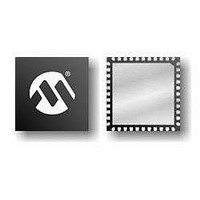PIC16F1937-E/MV Microchip Technology, PIC16F1937-E/MV Datasheet - Page 147

PIC16F1937-E/MV
Manufacturer Part Number
PIC16F1937-E/MV
Description
14KB Flash, 512B RAM, 256B EEPROM, LCD, 1.8-5.5V 40 UQFN 5x5x0.5mm TUBE
Manufacturer
Microchip Technology
Series
PIC® XLP™ 16Fr
Datasheet
1.PIC16F1937-EMV.pdf
(472 pages)
Specifications of PIC16F1937-E/MV
Processor Series
PIC16F
Core
PIC
Program Memory Type
Flash
Program Memory Size
14 KB
Data Ram Size
256 B
Interface Type
MI2C, SPI, EUSART
Number Of Timers
5
Operating Supply Voltage
1.8 V to 5.5 V
Maximum Operating Temperature
+ 125 C
Mounting Style
SMD/SMT
Package / Case
UQFN-40
Development Tools By Supplier
MPLAB IDE Software
Minimum Operating Temperature
- 40 C
Core Processor
PIC
Core Size
8-Bit
Speed
32MHz
Connectivity
I²C, LIN, SPI, UART/USART
Peripherals
Brown-out Detect/Reset, LCD, POR, PWM, WDT
Number Of I /o
36
Eeprom Size
256 x 8
Ram Size
512 x 8
Voltage - Supply (vcc/vdd)
1.8 V ~ 5.5 V
Data Converters
A/D 14x10b
Oscillator Type
Internal
Operating Temperature
-40°C ~ 125°C
Lead Free Status / Rohs Status
Details
- Current page: 147 of 472
- Download datasheet (5Mb)
12.6
PORTE is a 4-bit wide, bidirectional port. The
corresponding data direction register is TRISE. Setting a
TRISE bit (= 1) will make the corresponding PORTE pin
an input (i.e., put the corresponding output driver in a
High-Impedance mode). Clearing a TRISE bit (= 0) will
make the corresponding PORTE pin an output (i.e.,
enable the output driver and put the contents of the
output latch on the selected pin). The exception is RE3,
which is input only and its TRIS bit will always read as
‘1’.
Reading the PORTE register
the status of the pins, whereas writing to it will write to
the
read-modify-write operations. Therefore, a write to a
port implies that the port pins are read, this value is
modified and then written to the PORT data latch
(LATE). RE3 reads ‘0’ when MCLRE = 1.
12.6.1
The ANSELE register
configure the Input mode of an I/O pin to analog.
Setting the appropriate ANSELE bit high will cause all
digital reads on the pin to be read as ‘0’ and allow
analog functions on the pin to operate correctly.
The state of the ANSELE bits has no effect on digital
output functions. A pin with TRIS clear and ANSEL set
will still operate as a digital output, but the Input mode
will be analog. This can cause unexpected behavior
when executing read-modify-write instructions on the
affected port.
The TRISE register
pin output drivers, even when they are being used as
analog inputs. The user should ensure the bits in the
TRISE register are maintained set when using them as
analog inputs. I/O pins configured as analog input always
read ‘0’.
2008-2011 Microchip Technology Inc.
Note:
Note:
Example 12-1
PORT
PORTE Registers
ANSELE REGISTER
RE<2:0>
available
PIC16(L)F1937 only.
The ANSELE bits default to the Analog
mode after Reset. To use any pins as
digital general purpose or peripheral
inputs, the corresponding ANSEL bits
must be initialized to ‘0’ by user software.
latch.
shows how to initialize an I/O port.
(Register
and TRISE<2:0>
All
on
(Register
12-19) controls the PORTE
write
PIC16(L)F1934
(Register
12-21) is used to
operations
12-18) reads
pins
and
are
are
12.6.2
Each PORTD pin is multiplexed with other functions. The
pins, their combined functions and their output priorities
are shown in
When multiple outputs are enabled, the actual pin
control goes to the peripheral with the highest priority.
Analog input and some digital input functions are not
included in the list below. These input functions can
remain active when the pin is configured as an output.
Certain digital input functions override other port
functions and are included in
TABLE 12-11: PORTE OUTPUT PRIORITY
Note 1:
Pin Name
RE0
RE1
RE2
PIC16(L)F1934/6/7
Priority listed from highest to lowest.
PORTE FUNCTIONS AND OUTPUT
PRIORITIES
Table
SEG21 (LCD)
CCP3/P3A (CCP)
RE0
SEG22 (LCD)
P3B (CCP)
RE1
SEG23 (LCD)
CCP5 (CCP)
RE2
12-11.
Function Priority
Table
12-11.
DS41364E-page 147
(1)
Related parts for PIC16F1937-E/MV
Image
Part Number
Description
Manufacturer
Datasheet
Request
R

Part Number:
Description:
IC, 8BIT MCU, PIC16F, 32MHZ, SOIC-18
Manufacturer:
Microchip Technology
Datasheet:

Part Number:
Description:
IC, 8BIT MCU, PIC16F, 32MHZ, SSOP-20
Manufacturer:
Microchip Technology
Datasheet:

Part Number:
Description:
IC, 8BIT MCU, PIC16F, 32MHZ, DIP-18
Manufacturer:
Microchip Technology
Datasheet:

Part Number:
Description:
IC, 8BIT MCU, PIC16F, 32MHZ, QFN-28
Manufacturer:
Microchip Technology
Datasheet:

Part Number:
Description:
IC, 8BIT MCU, PIC16F, 32MHZ, QFN-28
Manufacturer:
Microchip Technology
Datasheet:

Part Number:
Description:
IC, 8BIT MCU, PIC16F, 32MHZ, QFN-28
Manufacturer:
Microchip Technology
Datasheet:

Part Number:
Description:
IC, 8BIT MCU, PIC16F, 32MHZ, SSOP-20
Manufacturer:
Microchip Technology
Datasheet:

Part Number:
Description:
IC, 8BIT MCU, PIC16F, 20MHZ, DIP-40
Manufacturer:
Microchip Technology
Datasheet:

Part Number:
Description:
IC, 8BIT MCU, PIC16F, 32MHZ, QFN-28
Manufacturer:
Microchip Technology
Datasheet:

Part Number:
Description:
IC, 8BIT MCU, PIC16F, 20MHZ, MQFP-44
Manufacturer:
Microchip Technology
Datasheet:

Part Number:
Description:
IC, 8BIT MCU, PIC16F, 20MHZ, QFN-20
Manufacturer:
Microchip Technology
Datasheet:

Part Number:
Description:
IC, 8BIT MCU, PIC16F, 32MHZ, QFN-28
Manufacturer:
Microchip Technology
Datasheet:

Part Number:
Description:
MCU 14KB FLASH 768B RAM 64-TQFP
Manufacturer:
Microchip Technology
Datasheet:

Part Number:
Description:
7 KB Flash, 384 Bytes RAM, 32 MHz Int. Osc, 16 I/0, Enhanced Mid Range Core, Low
Manufacturer:
Microchip Technology

Part Number:
Description:
14KB Flash, 512B RAM, 256B EEPROM, LCD, 1.8-5.5V 40 UQFN 5x5x0.5mm TUBE
Manufacturer:
Microchip Technology










